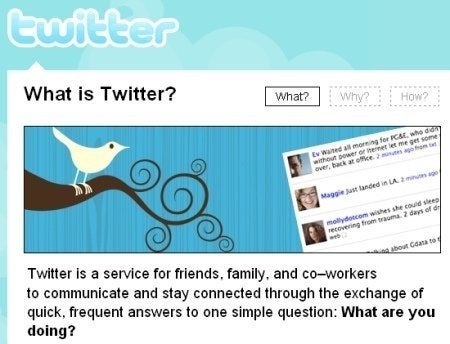
David Parry started using Twitter with his University of Texas at Dallas students in 2007. A teacher at Hope Charter School in Philadelphia, PA taught his students to mark themselves present and record their in-class accomplishments on the site. Penn State professor Cole Camplese maintains a screen full of his students' Twitter streams throughout each class.
Laymen have replaced trained experts as the people who define what's true in our world, and some educators are embracing the collaborative trend. As traditional reporting gives way to citizen journalism, and user-generated review sites like Yelp attract more traffic than renowned publications like Zagat, it's prudent to teach collaboration, too.
This year, M.I.T.'s physics department moved away from professorial spiels and toward group work. "Just as you can't become a marathon runner by watching marathons on TV," said Harvard Professor Eric Mazur, who influenced M.I.T. to shift, "likewise for science, you have to go through the thought processes of doing science and not just watch your instructor do it." The upshot: a more than 50-percent drop in failure rate.
Teaching students to learn from and with each other is a wise acknowledgment that more and more, students are relying on their peers for information. Sixty-five percent of Americans aged 12-17 and 67 percent of those aged 18-32 use social networking sites, according to the Pew Research Center. Students' lives are infused with each other's viewpoints.
Teachers and professors like Parry and Camplese are taking group work to the next logical step: incorporating social media into their classrooms. In lieu of fighting teens' use of networking sites, they are communicating with students in a language that they understand.
Parents -- especially of younger students -- don't always love the idea of their kids using social media. "I guess my point is (IMHO) if I found out that my 6th grader's school time was being used to learn about Twitter, MySpace, or any other social tool, that school would be getting a rather terse phone call from me. Teach my kid math, english, history, etc. I'll teach him about twitter etc....when I think he's ready and so that I can set boundaries," one father wrote in response to a post on using Twitter in the classroom.
This argument is akin to that for abstinence-only education. Kids with access to the Internet are going to use it whether or not their parents decide they're "ready." Teachers who enable students to use sites like Twitter for maximum gain -- to learn from their peers, converse around issues that matter to them, and follow people they admire -- build on students' experience rather than encourage it to develop black market-style.
Bringing social media into classrooms is "challenging the 1000-yr-old paradigm that you have to learn from a master and the only way to do that is to go to lecture and take notes," said Howard Rheingold, who teaches at UC Berkeley's School of Communication and Stanford University. He has also developed the Social Media Classroom, a set of tools for professors to incorporate Internet-based collaboration into their classes.
Rheingold points to five reasons for teaching students social media:
- Developing students' literacy in our new online environment is as crucial as developing their abilities to read and write. Communication is moving toward social media. We can either help students thrive in this environment or leave them flailing.
- Many students bring their computers to class. Why not work with this trend instead of fighting or ignoring it?
- Social media is just that: social. Students who use Twitter for class are "learning collaborative skills that are particularly important today."
- There is only so much class time. Rheingold makes mini-lectures on video that students comment on between classes, allowing more time to engage the issues through in-class discussion.
- Shy students who hold back in class often speak up online. "If you can extend the discussion to an online message board, you enable students who may not jump into the discussion," he said, to "make a thoughtful contribution."
Other teachers and professors cite similar benefits. "The first thing I noticed when the class started using Twitter was how conversations continued inside and outside of class," Parry wrote in 2008 of his college students. "Once students started twittering I think they developed a sense of each other as people beyond the classroom space."
Bringing sites like Twitter into the educational space is unorthodox. Skeptics argue that writing in 140-character bursts ruins students' spelling and grammar, that social media will become an excuse for students to chit-chat their way through class, that micro-blogging services are ruining kids' attention spans.
But the point of teaching students to use social media isn't just to embrace a novel trend: it's to help students become literate in our networking-based society. Like teaching students to use condoms, it's not about doing it, but doing it right.